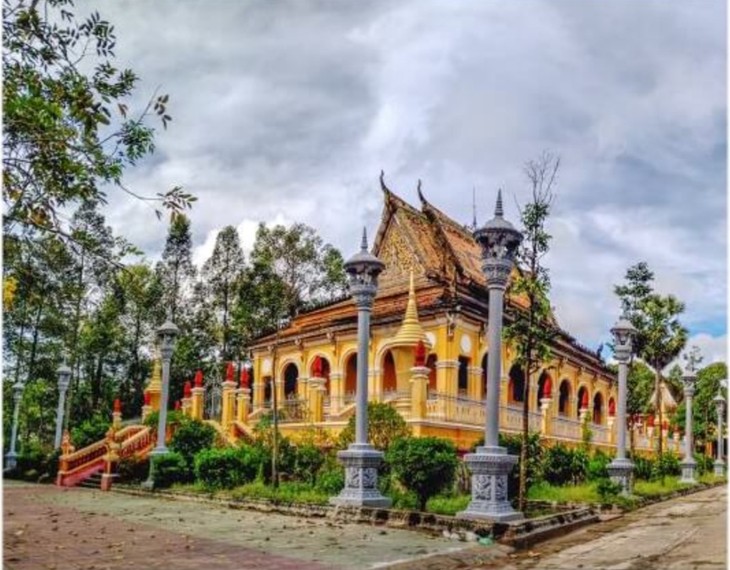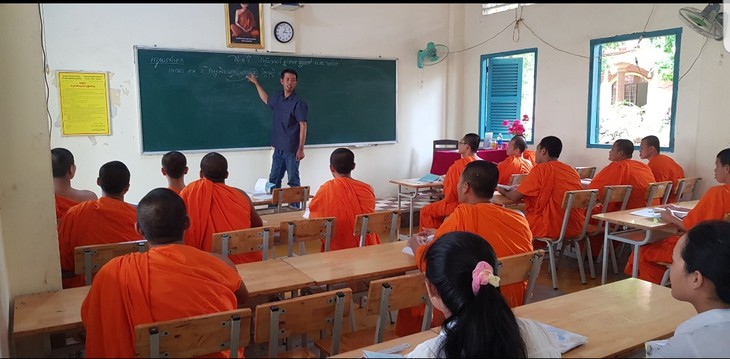Ong Met Pagoda is one of the oldest pagodas of the Khmer in the Mekong Delta province of Tra Vinh. The Theravada Buddhism pagoda with a Khmer architectural style has remained intact. The Ministry of Culture, Sports and Tourism recognized it as a national relic site in March, 2009.

Ong Met Pagoda is located on Le Loi Street, Tra Vinh city, Tra Vinh province (Photo Ngoc Anh)
Located on Le Loi Street, Ong Met Pagoda is one of the biggest and most ancient pagodas in Tra Vinh city, along with the Ang Pagoda and Hang Pagoda. As the headquarters of the Executive Board of the Maha Nikaya Order of the Khmer Theravada Buddhism, the Pagoda has contributed to the preservation and promotion of traditional Khmer culture and Theravada Buddhism.
The gate, main hall, synagogue house, flagpole, monks’ houses, and towers were built during different times with different materials. But these independent works exist harmoniously.
Monk Thach Oai, Vice Chairman of the Council of Patriotic Monks of Tra Vinh province and head of Ong Met Pagoda, told us a story about the pagoda’s history: “The pagoda was built in 642. Its old name was Wat Kompong, which means Wharf Pagoda because it’s close to a river and a wharf for boats to anchor. Then it was renamed Bodhisàlaraja, which means the Bodhi tree, a symbol of enlightenment. The Bodhi tree is like the King of trees. Legend says that there was a Buddha statue in the canal. Local people wanted to bring the statue to the temple, but failed to lift it out of the water. One night, a monk had a dream that they had to perform a ritual and tie a cord to the statue and pull it out. The people did as the dream told them and were able to move the Buddha statue to the temple.”
Monk Thach Oai added that the pagoda, which covers an area of 12,700 square meters, is being restored and construction is expected to be completed in 2023.
Ong Met Pagoda has a majestic entrance with 8 pillars supporting the roof of the gate. The top of each pillar is carved with the Keyno bird symbolizing a cordial welcoming to visitors. The two sides of the gate are beautiful walls decorated with pairs of seven-headed snakes, a sacred symbol for the Khmer.
In a bird's-eye view, the roof of the main hall of Ong Met Pagoda looks like a flock of dragons looking in four directions. The main hall is supported by 32 precious wooden pillars. The pillars and beams are carved with golden lacquered patterns. In the front and at the back of the main hall, there are two wooden panels elaborately carved with images of the cultural and spiritual life of the southern Khmer people.
On the altar inside the main hall sits a majestic statue of Shakyamuni Buddha on a lotus flower which is 4.4 m high, 5 m long, and 4.3 m wide. This is one of the biggest Buddha statues in Tra Vinh province.


A class at Ong Met Pagoda (Photo: Ngoc Anh)
Behind the main hall is the library built with the unique wooden house architecture of the southern Khmer. All 24 pillars and beams are elaborately carved and painted with gold lacquer. The library has three compartments with the middle space to store books and reading spaces on both sides.
Generations of monks have studied at Ong Met Pagoda, including prestigious dignitaries. Most Venerable Sơn Kenne of Ong Met Pagoda said: “All Theravada Buddhism pagodas hold elementary and intermediate classes on Buddhism. The elementary course runs for three years and intermediate course is four years. There are classes for monks and Buddhist followers.”
All 143 pagodas in Tra Vinh province open classes for monks and ordinary people of all ages.
Monk Kim Hoang Trung comes from Tra Cu district to study at Ong Met Pagoda: “I study nine months of a year. Every month I have four days off. We study 10 subjects, including Vietnamese, Khmer, Balinese, mathematics, and literature. Our teacher volunteers to work for free. He studied doctorate in India and returned home to teach Balinese.”
Ong Met Pagoda is a symbol of the southern Khmer Theravada sect. It’s not only a religious center but also a cultural center for community gatherings.
Ngoc Anh